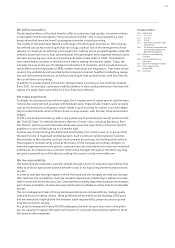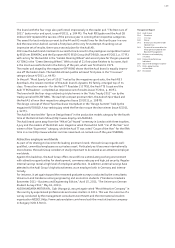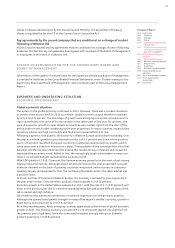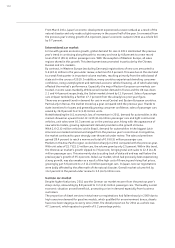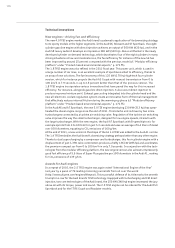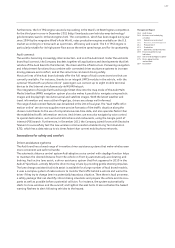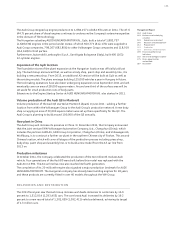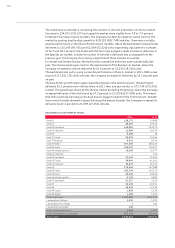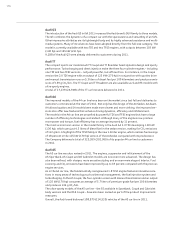Audi 2011 Annual Report Download - page 149
Download and view the complete annual report
Please find page 149 of the 2011 Audi annual report below. You can navigate through the pages in the report by either clicking on the pages listed below, or by using the keyword search tool below to find specific information within the annual report.
146
Technical innovations
New engines – driving fun and efficiency
The new 4.0 TFSI engine marks the Audi brand’s systematic application of its downsizing strategy
to its sporty models in the higher segments. In the Audi S6, S6 Avant and S7 Sportback, the eight-
cylinder gasoline engine with direct injection achieves an output of 309 kW (420 hp), and in the
Audi S8 luxury sedan it develops an impressive 382 kW (520 hp). Above all thanks to the newly
developed cylinder on demand technology, which deactivates four of the eight cylinders in many
driving situations at low and moderate revs, the fuel efficiency for instance of the new S6 has
been improved by around 25 percent compared with the previous model (cf. “Modular efficiency
platform” under “Product-based environmental aspects,” p. 172 ff.).
The 1.8 TFSI engine was also refined in the 2011 fiscal year. This power unit, which is used in
a large number of car lines, is an excellent example of sportiness allied to efficiency, thanks to
an array of new solutions. The fuel economy of this 125 kW (170 hp) high-tech four-cylinder
version, which for instance propels the Audi A5 Coupé with manual transmission from 0 to
100 km/h in 7.9 seconds, is up to 18 percent better than that of the previous version. The
1.8 TFSI engine incorporates various innovations that have paved the way for this increased
efficiency. For instance, alongside gasoline direct injection, it also uses indirect injection to
produce improved mixture swirl. Exhaust gas cooling integrated into the cylinder head and the
new all-electronic coolant regulation system create an innovative form of thermal management
that effectively reduces internal friction during the warming-up phase (cf. “Modular efficiency
platform” under “Product-based environmental aspects,” p. 172 ff.).
In the Audi A6 and A7 Sportback, the new 3.0 TDI engine developing 230 kW (313 hp) has spear-
headed the diesel engine range since the end of 2011. This biturbo unit is driven by two inline
turbochargers connected by a turbine air switching valve. Regulation of the turbine air switching
valve improves the way the small turbocharger, designed for low engine speeds, interacts with
the large turbocharger. With the new engine, the Audi A7 Sportback with 8-speed tiptronic for
example sprints from 0 to 100 km/h in just 5.3 seconds and uses an average of 6.4 liters of diesel
over 100 kilometers, equating to CO₂ emissions of 169 g/km.
At the end of 2011, a new version in the shape of the A1 1.4 TFSI was added to the Audi A1 car line.
The 1.4 TFSI embodies the Audi brand’s downsizing strategy perhaps better than any other engine.
Thanks to dual supercharging by a compressor and turbocharger, this four-cylinder engine with a
displacement of just 1,390 cubic centimeters produces a hefty 136 kW (185 hp) and accelerates
the premium compact car from 0 to 100 km/h in only 7.0 seconds. In conjunction with the tech-
nologies from the modular efficiency platform, the new engine version also achieves impressively
good fuel efficiency of 5.9 liters of Super Plus gasoline per 100 kilometers in the Audi A1, making
for CO₂ emissions of 139 g/km.
Awards for Audi engines
In a repeat of 2010, the 2.5 TFSI engine was again voted “International Engine of the Year”
last year by a panel of 76 leading motoring journalists from all over the world
(http://www.ukipme.com/engineoftheyear). This successful defense of its title marks the seventh
triumph in a row for the Audi brand’s TFSI technology. Equipped with turbocharging and FSI direct
injection, two core technologies of the Audi brand, the 250 kW (340 hp) engine impressed the jury
above all with its torque, power and sound. The 2.5 TFSI engine can be ordered for the Audi RS 3
Sportback and for the TT RS Coupé and Roadster models.



